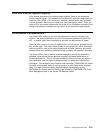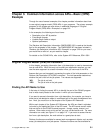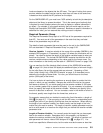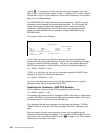Locks are based on the objects that the API uses. The type of locking that occurs,
such as whether the object can be used by more than one user at the same time,
is based on what actions the API performs on the object.
For the QWDRJOBD API, you must have *USE authority to both the job description
object and the library to access the object. This is the same type of authority that
is required for most situations where you want to display or retrieve information in
an object. For example, it is the same authority that you would need to use the
Display Job Description (DSPJOBD) command. Because no specific information is
described for locks, you can assume that nothing unusual is required.
Required Parameter Group
The Required Parameter Group topic of an API lists all the parameters required for
that API. You must use all of the parameters in the order that they are listed.
None of the parameters may be left out.
The details of each parameter that must be used on the call to the QWDRJOBD
API are described in “Required Parameter Group” on page 3-30.
Receiver Variable:
A receiver variable is the name of the variable (QWDBH in the
example RPG program in “Parameters” on page 3-2) where the information will be
placed. You need to declare the length of the receiver variable based on what you
want from the format. The include file QWDRJOBD contains the definition for the
receiver variable structure depending on the value used for the format name. For
more information on the format, see the table in “JOBD0100 Format” on page 3-30.
You can see from the
Dec
(decimal offset) column of the JOBD0100 format table
(1 on page 3-31) that at least 390 bytes plus additional bytes (of unknown length)
for the initial library list and the request data are returned. “Accessing a Field
Value (Initial Library List)—OPM RPG Example” on page 3-19 describes how to
determine the lengths of these fields. For now, you should focus on the fixed
portion (390 bytes) of the format.
You have a choice of receiving the maximum or enough bytes to contain the infor-
mation in which you are interested. Because the value of the hold on job queue
field starts at decimal 76, you could specify that the receiver variable is 100 bytes
(or any number greater than or equal to 86 bytes). It is not necessary to be precise
when you specify the length of the receiver variable. Whatever you specify is the
amount of data that is returned. You can truncate a value in the middle of a field in
the format, specify more length than the format has, and so on.
For example, assume that you decided to receive the fixed information, a length of
390 (2 on page 3-7). If you are going to call the API once, no measurable perfor-
mance gain occurs if you specify anything less than the maximum. When defining
the length of your receiver variable, you would usually use the length of the infor-
mation that you want to receive. The length of receiver variable parameter must be
set to a value equal to or less than the length that you defined the receiver variable
parameter to be.
Length of Receiver Variable:
You normally enter the length that you have speci-
fied for the receiver variable. Remember that in this example, you decided to
declare the receiver variable to be 390 bytes in length. The length of receiver vari-
able parameter will have a value of 390 assigned to it (3 on page 3-7). You
could have specified a different value, but the value must be the same or less than
Chapter 3. Common Information across APIs—Basic (OPM) Example 3-3


















